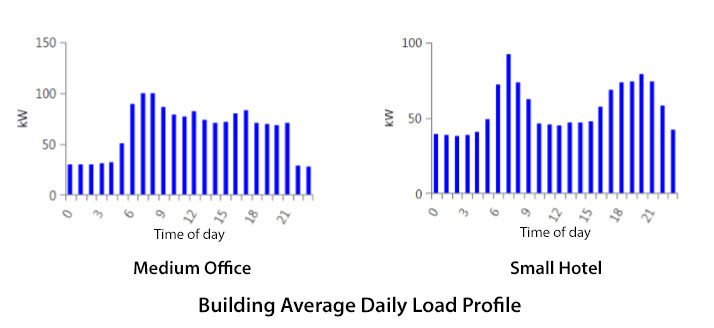Producing too much solar power? Here’s how you can manage the excess
Credit to Author: Vanya Ignatova| Date: Thu, 12 Sep 2019 12:00:36 +0000
In installations with photovoltaic production, the building electrical energy consumption does not always match the photovoltaic production. The degree of this mismatch depends on the building activity and its consumption profile, but it is globally true for a majority of buildings.
Residential buildings and hotels consume more energy in the morning and in the evening when solar irradiation is low. Load consumption is therefore not synchronized with the photovoltaic power production profile. Under these conditions, photovoltaic self-consumption is effective only if a good portion of end-user usage is shifted to the hours of sunlight.
Office buildings, schools, and shopping malls generally experience the majority of their electrical consumption during the daytime. However, on weekends or other days off, these buildings have a quite different consumption profile, characterized by lower flat consumption. Moreover, the majority of schools and universities curtail their activities during the summer months and so consume much less energy, or in some cases almost no energy at all.

Industrial buildings may have generally flat consumption but also experience periods of low demand, depending on the organization of their activities. This is another case where the photovoltaic production profile does not match consumption well.
Indeed, solar power is characterized by a daily production profile that depends on weather conditions, with no production at night. Combining these considerations with the variability of different buildings’ consumption profiles—including variations due to changing seasons and the days of the week—it is quite difficult to match building consumption with photovoltaic production. Therefore, excess photovoltaic production happens relatively often, even when the photovoltaic system is sized so that it does not exceed the building baseload consumption.

Alternatives for managing excess solar production
When the locally produced power exceeds the consumption loads, there are several possible options for managing the excess power:
- Inject it to the grid
- Limit the photovoltaic production
- Store the photovoltaic excess to use it later
- Shift some loads to the period of photovoltaic production
These technologies are explained in the video “Four ways to manage excess photovoltaic production,” the second installment in a new video series produced by Schneider Electric’s technical communication and training group.
Of these four alternatives, two hold great promise for the future.
Storage systems that store the excess of the solar production and make the electricity available for use later in the day can be very effective. Today, however, this option is costly and often has a long payback period. To improve the return on investment, storage can be associated with other use cases, such as providing a backup power supply, improving demand response, and avoiding peak power usage to enable subscribing to a low power contract. This approach is more fully explained in another video in this series.
Load management is a very attractive option that consists of simply making some loads operate during the period of photovoltaic production, when that is possible. These loads must be flexible and manageable through the control system. Examples include electrical vehicle charging, water heating, and HVAC (heating, ventilating, and air conditioning) to a certain extent. 
The load management strategy has obvious advantages: It is cost effective, easy to implement, and guarantees a quick payback. Unlike a storage integration solution, it does not require the installation of additional equipment and thus presents a better profitability.
When a load shifting strategy is not enough to absorb the total excess of photovoltaic production, it can be used in association with a storage system. In that case, load shifting offers the additional benefit of reducing the size—and optimizing the use—of the storage system.
As the below video suggests, a combination of the four possible options—grid injection, power limitation, storage, and the very attractive alternative of load shifting—frequently turns out to be the best way to manage excess photovoltaic production.
Storage and other topics related to self-consumption of solar power are addressed in other installments of this blog and video series.
Learn more about Schneider Electric Solar, including new products and services for applications from residential solar to utility-scale power plants and how Schneider Electric’s cloud based, demand-side energy management software platform collects, forecasts, and automatically optimizes distributed energy resource (DER) operations.
The post Producing too much solar power? Here’s how you can manage the excess appeared first on Schneider Electric Blog.